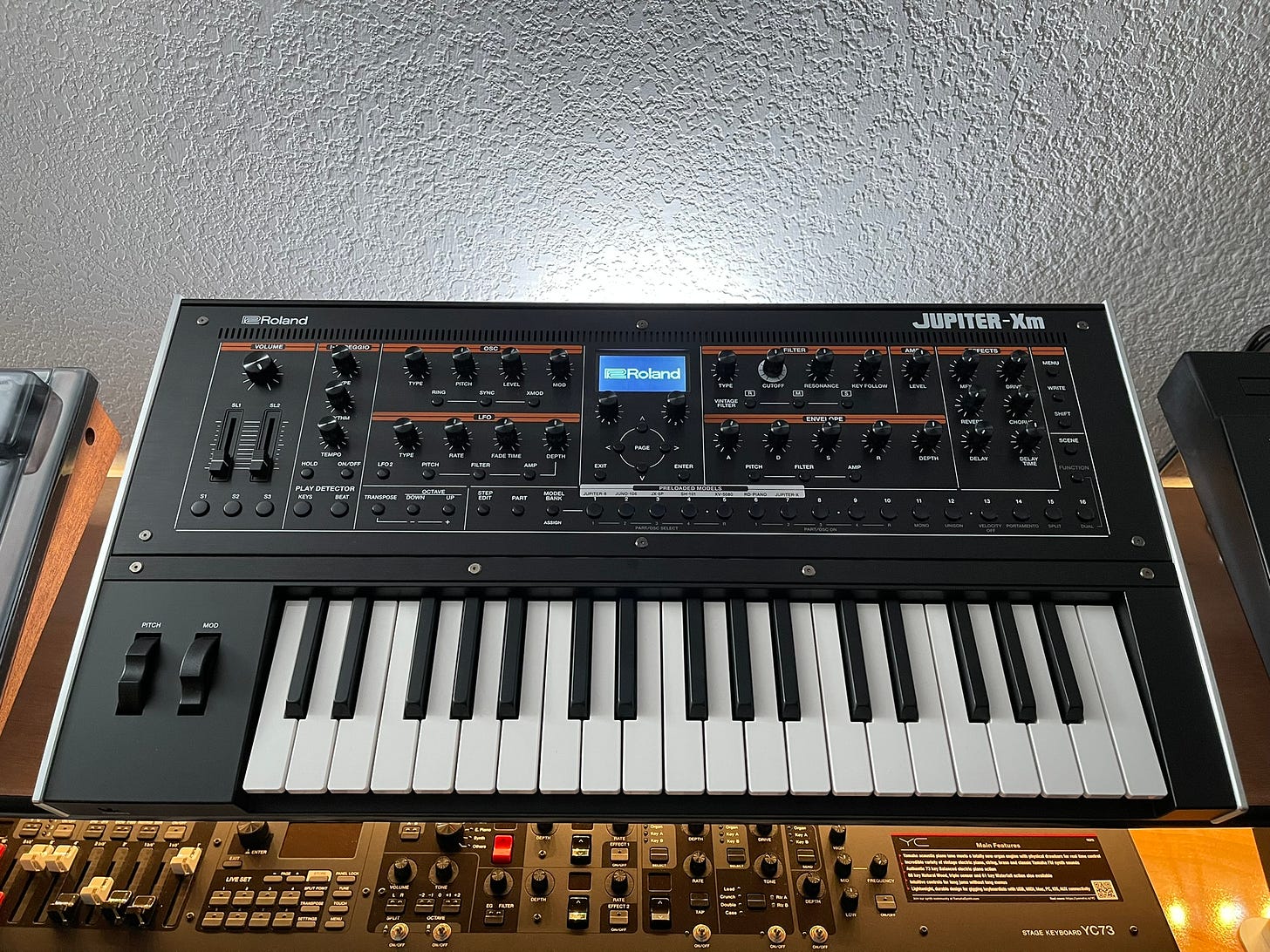Roland JUPITER-Xm: Vintage Soul Meets Modern Innovation
How Roland's Compact Powerhouse Brings Classic Synth Magic into the Modern Era
The Roland JUPITER-Xm stands as a testament to how far music technology has come, packaging the soul of legendary synthesizers into a portable powerhouse.
This comprehensive review explores how Roland has managed to capture the essence of iconic instruments like the Jupiter-8, Juno-106, and SH-101 in a compact form factor that doesn't compromise on sound quality or functionality.
Whether you're a touring musician, studio producer, or passionate hobbyist, the JUPITER-Xm offers a fascinating blend of vintage character and modern innovation.
Note: This article is an adaptation of my YouTube video above. I’ve also linked the song I created with only the JUPTER-Xm, a Maschine+, and Yamaha YC for its lead sound below and on SoundCloud:
A Legacy Reborn
The story of the JUPITER-Xm begins with its legendary ancestors. In 1981, Roland released the Jupiter-8, one of the first polyphonic analog synthesizers that would go on to define the sound of an era.
Its rich, warm tones became the backbone of countless hits throughout the 1980s, establishing Roland's Jupiter series as a cornerstone of electronic music production.
Fast forward to today, and the JUPITER-Xm carries this torch into the modern age, albeit with some significant technological advances.
What sets the JUPITER-Xm apart isn't just its historical lineage – it's how Roland has managed to capture the essence of multiple classic synthesizers in a single, portable instrument.
This isn't merely a matter of loading up samples; the JUPITER-Xm utilizes Roland's sophisticated ZEN-Core Synthesis System to recreate the actual behavior of these vintage instruments, right down to their distinctive quirks and characteristics.
Beyond Simple Emulation
The JUPITER-Xm's ZEN-Core Synthesis System deserves special attention. Unlike many modern digital synthesizers that rely on sample playback, this system recreates the original waveforms and filter responses of classic Roland synthesizers with remarkable accuracy.
This approach means that when you're playing a Jupiter-8 patch on the JUPITER-Xm, you're experiencing something very close to the real thing – not just in terms of sound, but in terms of how the instrument responds to your playing and parameter adjustments.
According to Roland's official website, the ZEN-Core engine represents their most advanced synthesis architecture to date. It's capable of producing everything from faithful vintage recreations to entirely new sounds that weren't possible with the original hardware.
This combination of authentic modeling and modern capabilities makes the JUPITER-Xm a uniquely versatile instrument.
Multitimbral Mastery
One of the JUPITER-Xm's most powerful features is its multitimbral capability. The ability to layer up to five different sounds simultaneously – four synth parts and one drum part – opens up incredible possibilities for both live performance and studio production.
Each part can be assigned to different MIDI channels, effectively turning the JUPITER-Xm into a complete electronic ensemble.
This multitimbral architecture allows musicians to create complex arrangements that would typically require multiple pieces of hardware. Imagine combining the following in a single performance:
A deep, resonant Jupiter-8 bass line
Ethereal Juno-106 pads floating in the background
JX-8P plucks
Crisp, dynamic SH-101 arpeggios
Punchy TR-707 drum patterns
When paired with modern sequencer like the Akai MPC or Native Instruments Maschine+, the JUPITER-Xm becomes an incredibly powerful production tool.
Professional producers have noted that this combination of vintage sound character and modern workflow capabilities makes the JUPITER-Xm particularly valuable in contemporary music production environments.
Portability Meets Power
Despite its impressive sound engine and multitimbral capabilities, the JUPITER-Xm maintains a remarkably compact form factor. This achievement shouldn't be understated – packing multiple synthesizer engines and a drum machine into a portable, battery-powered unit is no small feat.
This portability doesn't come at the expense of build quality or playability. The keyboard, while smaller than full-size keys, offers good tactile response and velocity sensitivity.
The control layout is intuitive (once you understand the basics), with essential parameters readily accessible via physical controls, and the build quality maintains Roland's reputation for durability, making the JUPITER-Xm suitable for both studio use and live performance.
Modern Conveniences
The JUPITER-Xm includes several modern features that enhance its utility in contemporary music production:
Built-in USB audio interface functionality allows direct recording to a computer without additional hardware. The synth can also receive MIDI over USB, making it easy to integrate with digital audio workstations (DAWs) and other modern music production tools.
Bluetooth MIDI connectivity enables wireless control from mobile devices, opening up new possibilities for performance and sound editing. This feature makes the JUPITER-Xm particularly appealing to musicians who incorporate tablets and smartphones into their setup.
The I-Arpeggio feature uses artificial intelligence to generate musically appropriate phrases based on your playing style, adding another layer of creative possibility to the instrument.
Sound Design and Preset Management
The JUPITER-Xm comes with an extensive library of preset sounds that showcase its versatility. These presets aren't just simple recreations – they're carefully crafted to take advantage of the instrument's modern capabilities while maintaining the character of the original hardware they're based on.
Sound designers will appreciate the depth of control available through the synthesis engine. While the interface may seem simple at first glance, diving into the menu system reveals extensive modulation options, effects routing capabilities, and fine-tuning parameters that allow for precise sound sculpting.
The Perfect Balance
What makes the JUPITER-Xm particularly special is how it bridges the gap between vintage and modern synthesis. It's not trying to be a mere replica of classic synthesizers – instead, it takes the best aspects of these legendary instruments and reimagines them for contemporary music production.
The ability to run on batteries for up to several hours makes it an ideal companion for mobile music creation. Whether you're composing on a train, performing at an outdoor event, or just want the freedom to make music away from your studio, the JUPITER-Xm delivers professional-quality sound in a highly portable package.
Integration with Modern Workflows
In today's hybrid music production environments, the JUPITER-Xm shines as a versatile tool that can adapt to various workflows. Its USB connectivity and MIDI implementation make it equally at home in a traditional hardware setup or as part of a computer-based production system.
The Scene function allows you to store complete multitimbral setups, including all sound parameters, effects settings, and routing configurations. This feature is particularly valuable for live performers who need to switch between complex arrangements quickly and reliably.
Conclusion
The Roland JUPITER-Xm (affiliate link) represents a remarkable achievement in modern synthesis. It successfully captures the essence of Roland's most beloved vintage synthesizers while adding contemporary features that make it relevant for today's musicians.
Its combination of authentic sound reproduction, multitimbral capabilities, and portable design makes it an incredibly versatile instrument for both studio production and live performance.
Whether you're a longtime fan of vintage synthesizers or a modern producer looking to add some classic character to your sound palette, the JUPITER-Xm offers an impressive balance of features, sound quality, and portability.
It's a worthy addition to Roland's legendary Jupiter series and a testament to how far music technology has come.
Don't Miss Out!
Love diving deep into the world of vintage synthesizers (and modern recreations)? Subscribe to Retrothusiast on Substack to never miss an update.
Join our community on Substack Chat to connect with fellow retro enthusiasts and share your own experiences with classic gear.
Whether you're a seasoned pro or just starting your journey into the world of electronic music, there's always something new to discover together.




